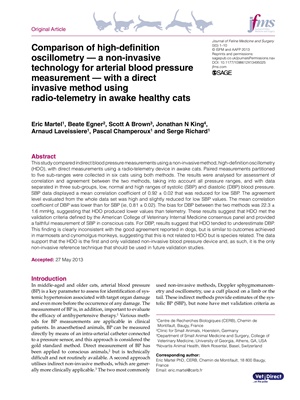
Journal of Feline Medicine and Surgery
0(0) 1 -10
© ISFM and AAFP 2013
Reprints and permissions:
sagepub.co.uk/journalspermissions.nav
DOI: 10.1177/1098612X13495025
jfms.com
Introduction
In middle-aged and older cats, arterial blood pressure
(BP) is a key parameter to assess for identification of systemic hypertension associated with target
organ damage
and even more before the occurrence of any damage. The
measurement of BP is, in addition, important to evaluate
the efficacy of antihypertensive therapy.1 Various methods for BP
measurements are applicable in clinical
patients. In anaesthetised animals, BP can be measured
directly by means of an intra-arterial catheter connected
to a pressure sensor, and this approach is considered the
gold standard method. Direct measurement of BP has
been applied to conscious animals,2 but is technically
difficult and not routinely available. A second approach
utilises indirect non-invasive methods, which are generally more
clinically applicable.3 The two most commonly
used non-invasive methods, Doppler sphygmomanometry and oscillometry,
use a cuff placed on a limb or the
tail. These indirect methods provide estimates of the systolic BP
(SBP), but none have met validation criteria as
Comparison of high-deinition
oscillometry - a non-invasive
technology for arterial blood pressure
measurement - with a direct
invasive method using
radio-telemetry in awake healthy cats
Eric Martel1, Beate Egner2, Scott A Brown3, Jonathan N King4,
Arnaud Laveissiere1, Pascal Champeroux1 and Serge Richard1
Abstract
This study compared indirect blood pressure measurements using a non-invasive method, high-definition oscillometry
(HDO), with direct measurements using a radio-telemetry device in awake cats. Paired measurements partitioned
to five sub-ranges were collected in six cats using both methods. The results were analysed for assessment of
correlation and agreement between the two methods, taking into account all pressure ranges, and with data
separated in three sub-groups, low, normal and high ranges of systolic (SBP) and diastolic (DBP) blood pressure.
SBP data displayed a mean correlation coefficient of 0.92 ± 0.02 that was reduced for low SBP. The agreement
level evaluated from the whole data set was high and slightly reduced for low SBP values. The mean correlation
coefficient of DBP was lower than for SBP (ie, 0.81 ± 0.02). The bias for DBP between the two methods was 22.3 ±
1.6 mmHg, suggesting that HDO produced lower values than telemetry. These results suggest that HDO met the
validation criteria defined by the American College of Veterinary Internal Medicine consensus panel and provided
a faithful measurement of SBP in conscious cats. For DBP, results suggest that HDO tended to underestimate DBP.
This finding is clearly inconsistent with the good agreement reported in dogs, but is similar to outcomes achieved
in marmosets and cynomolgus monkeys, suggesting that this is not related to HDO but is species related. The data
support that the HDO is the first and only validated non-invasive blood pressure device and, as such, it is the only
non-invasive reference technique that should be used in future validation studies.
Accepted: 27 May 2013
1 Centre de Recherches Biologiques (CERB), Chemin de
Montifault, Baugy, France
2Clinic for Small Animals, Hoerstein, Germany
3 Department of Small Animal Medicine and Surgery, College of
Veterinary Medicine, University of Georgia, Atheeric.martel@cerb.frNovartis Animal Health, Werk Rosental, Basel, Switzerland
Corresponding author:
Eric Martel PhD, CERB, Chemin de Montifault, 18 800 Baugy,
France
Email: eric.martel@cerb.fr
495025JFM0010.1177/1098612X13495025Journal of Feline Medicine and SurgeryMartel et al
2013
Original Article